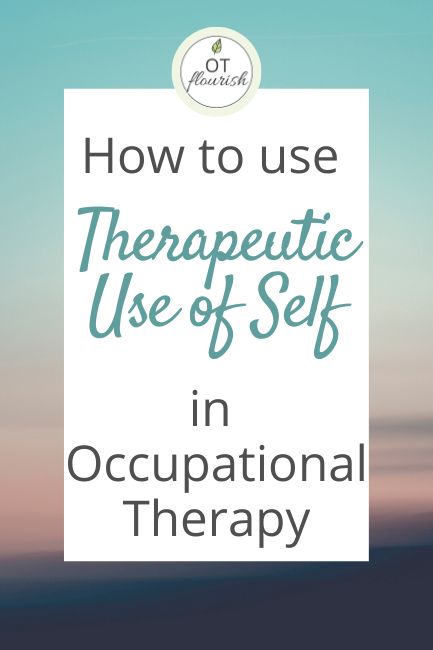How do we utilize therapeutic use of self in occupational therapy (OT)? Or should we?
It should come as no surprise that patients and clients are placed in a vulnerable position when undergoing rehabilitation after injury, disease, surgery, or any debilitating condition that inhibits function. Occupational therapy practitioners get to witness the good, the bad, and the ugly aspects of someone’s personality, preferences, and opinions. However, in order for the OT process to truly be effective from initial evaluation to discharge, the practitioner needs to reciprocate some vulnerability of their own.
This is where the term “therapeutic use of self” comes into play.
What is therapeutic use of self in occupational therapy?
This term was developed from several OT frameworks and psychoanalytic theories that all make a similar assumption: that the therapist can influence the outcome with the use of their own personality, perceptions, opinions, and judgments.
Utilizing these intentional techniques helps the therapeutic relationship and establishes:
- a healthy, professional relationship
- promotion of participation in occupational therapy services, and
- ways to guide the patients towards meeting their chosen occupational goals.
In short, OT practitioners remove the proverbial lab coat and get ready to make a new friend!
Check out this great podcast conversation with fellow OT, Michelle Yeramian, discussing how to use occupational therapy and the therapeutic use of self in everyday practice to maximize your rapport and get better results with your patients.
What are the 6 modes of therapeutic use of self?
The six modes of the therapeutic use of self, based on the Intentional Relationship Model (Taylor et al., 2009), are as follows:
- Advocating
- standing up for the patient and providing them with additional resources to enhance the therapeutic process.
- Collaborating
- including the patient in every aspect of planning and carrying out the therapeutic process.
- Empathizing
- understanding the patient’s internal, emotional experiences during the therapeutic process.
- Encouraging
- “cheerleading” or urging the patient to participate and progress.
- Instructing
- Taking on a teacher role to educate the patient.
- Problem-solving
- working with the patient to reason through and analyze complex therapeutic situations.
According to the assumptions of the Intentional Relationship Model (Taylor, R. R. 2008), not one single mode is more important or essential than the other. Additionally, the therapist learns to strategically juggle and apply each mode to influence the route of the therapeutic process for the patient to succeed.
Here is a great therapeutic use of self pdf you can reference as well!

Why is therapeutic use of self important in the OT profession?
Think back to why you went into the OT profession in the first place and why it stood out to you from other professions. The driving force and appeal behind numerous medical, healthcare, and psychiatric careers is “helping others.”
Actively applying any mode of the therapeutic use of self causes intentional interaction and relationship-building between patients and OTs. OT should be more than just planting a patient on an exercise bike and walking away – it is personalized and occupation based! Therapeutic use of self ensures the patient’s success, but also helps occupational therapists realize the uniqueness and specialized approach they have to offer to the healthcare world.
Using therapeutic use of self to connect with geriatric patients
For younger or inexperienced occupational therapy practitioners, connecting with their geriatric patients may seem daunting because you have no idea what you could possibly have in common with this population.
Oddly enough, therapists learn with time that finding common ground with older patients is not as challenging as you think or might be helpful if they are refusing services, such as in a SNF.
Just consider some of the following tips:
- Offer kind gestures such as a smile and a handshake in appropriately timed manners
- Ask about the patient’s interests, hobbies, talents, etc.
- Talk about your interests, hobbits, talents, and additional information that helps you find common ground
- Use wit and humor when appropriate
- Avoid pandering, fake praise, or making promises you have no intention or capacity to keep
- Be sensitive to culture, diversity and inclusiveness
- Avoid oversimplifying information to the point where you treating the patient like they are unintelligent
- Pay attention to signs of emotional and physical distress and offer ways to grade therapeutic tasks accordingly
- Keep your patient in the loop on their care plan, letting them make adaptations when needed or when possible

Therapeutic use of self examples in patient care
If you think that therapeutic use of self is pretty vague, you’re not wrong. Honestly, depictions of therapeutic use of self is going to look different for every intervention and therapist, thus resulting in an indefinite number of examples. However, here’s a few that may crop up in a geriatric setting:
- Instructing a patient with post-stroke hemiplegia how to use a new bath bench for home use.
- Removing a patient with schizophrenia from a busy therapy gym and conducting therapy in a private room because you take notice to their signs of emotional dysregulation and overstimulation to noise and overcrowding
- Encouraging the patient to speak up during interdisciplinary team meetings about their own progress in therapy
- Setting up a simulation obstacle course that mimics the patient’s home to help him practice furniture-walking during kitchen tasks after a total hip replacement
- Incorporating a patient’s interest in painting rather than using pegboards to address fine motor coordination skills for buttoning their shirts at home
- Sitting down with a patient for five minutes after a treatment session to review his goals and gather his opinion to update a “showering in sitting goal” to “showering in standing” goal
What does therapeutic use of self look like in the assessment process?
Using any or all aspects of the therapeutic use of self during the initial evaluation is essential for collecting raw and genuine results regarding the patient’s current and prior levels of function. To solicit this type of information means that the occupational therapist must earn the patient’s trust in order to collaboratively create meaningful goals.
Coming across as cold or distant will only make a scary medical situation worse for the patient. However, if the therapist takes a welcoming approach with great bedside manner with the intent to create a collaborative, professional relationship with the patient, then the patient may be more willing to open up and provide accurate assessment information.
Therapeutic use of self in occupational therapy should be a vital and regular occurrence to promote progress and effective use of interventions. It’s a practice that involves a little give and take between the therapist and the patient to establish trust. Therapeutic use of self provides a necessary outlet for the therapist’s strategically placed judgments, perceptions, opinions, and personality to influence how and when a patient masters their chosen goals.
References:
Donna A. Leber, Elizabeth G. Vanoli; Therapeutic Use of Humor: Occupational Therapy Clinicians’ Perceptions and Practices. Am J Occup Ther March/April 2001, Vol. 55(2), 221–226. doi: https://doi.org/10.5014/ajot.55.2.221
Taylor, R. R. (2008). The intentional relationship: Outpatient therapy and use of self. FA Davis
Taylor, R.R., Lee, S.W., Kielhofner, G., & Ketkar, M. (2009). Therapeutic Use of Self: A Nationwide Survey of Practitioners’ Attitudes and Experiences. American Journal of Occupational Therapy, March/April 63(2).





